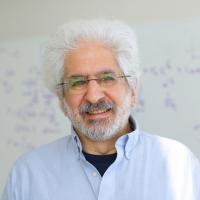Columbia-led Team Receives $16.75M from the BRAIN Initiative
Award unites different fields of brain research to foster an innovative, interdisciplinary approach to deciphering the brain.
Professor of Neuroscience; Principal Investigator at Columbia's Zuckerman Institute
Our mathematical models help us understand patterns within the brain that can’t be understood in any other way.
Award unites different fields of brain research to foster an innovative, interdisciplinary approach to deciphering the brain.

In the 1970s, Kenneth Miller, PhD, spent several years planting trees in the forests all over the western United States, as part of a worker-owned cooperative experimenting with alternatives to profit-driven capitalism. Out there, in the woods, he found himself dreaming of Einstein and general relativity.
Today he is a theoretical biologist, a scientist who borrows tools from physics and other quantitative fields to provide new insights into the brain, in the hopes of bettering humanity.
“Understanding the brain is a long-term project, but the more we understand about how the brain works, at a mechanistic level, the more we will understand about how to be mentally healthy and how to tackle neurological and mental illnesses,” said Dr. Miller, a principal investigator and Peter Taylor Professor at the Mortimer B. Zuckerman Mind Brain Behavior Institute at Columbia University.
He co-founded and co-directs the Institute’s Center for Theoretical Neuroscience, a remarkable collection of researchers who use data analysis and theoretical modeling to push the limits of neuroscience. This work is incredibly collaborative in nature. It brings together teams of experimentalists and theorists across a wide range of interests and research programs.
Dr. Miller’s own interdisciplinary approach to the brain has its origins in graduate school. A physicist by training, he began to take neuroscience classes. He discovered troves of data coming out of research labs that begged to be analyzed with mathematical tools traditionally applied to particles and other aspects of the physical world.
“In every research paper we read, there were these beautiful repeating patterns people were finding in the brain’s connections,” said Miller, now a professor of neuroscience at Columbia’s Vagelos College of Physicians and Surgeons. “It seemed to me that those patterns should emerge out of a model.”
Much of the experimental work he was reading focused on the visual cortex, one of the best-studied regions of the brain, which gives rise to our ability to see. So Dr. Miller started there. He found that mathematical models could help explain how cells in the brain develop the ability to identify the angle of a line seen by the eyes, for instance, or to favor information coming from one eye over the other, a phenomenon called ocular dominance.
As Dr. Miller has tackled topics ranging from how attention governs what we perceive to how individual cells change their behavior during learning, his models have revealed fundamental principles that govern how cells work together to behave, collectively, like circuits.
“Modeling provides a bridge between the low-level behaviors of individual cells in the brain and the behaviors of neural circuits of thousands or millions of cells. Further modeling in turn can bridge between the circuit activities and the high-level phenomena that give rise to the brain’s amazing abilities,” said Dr. Miller. “Modeling reveals new relationships and gives us new intuitions for how the brain is working.”
These models have, for example, revealed the broad importance of inhibition in the brain. He and his group found that the suppression of some cells by others creates feedforward circuits. These allow small inputs into the brain to drive large, rapid changes in the sensitivity of small groups of cells: turning up or down the gain, to borrow a term from electronics, of these circuits of cells. The researchers also found that the dynamics by which inhibition stabilizes excitation can explain how the brain tunes its responses to strong stimuli (imagine a bright light in a dark room) versus weak stimuli (picture a hazy shape in the fog).
Dr. Miller believes that much of what his theoretical methods have to say about vision can be applied to the cortex more generally, the structure of which is known to be fundamentally uniform, although with variations. This could help scientists explore not only how we perceive the world with our senses, but how we remember these sensations and learn from our experiences.
“We know that we’re missing a lot in terms of understanding the rules by which the cortex learns. The brain’s cells and connections must modify themselves based on their own patterns of activity, which embody the animal’s experience, in ways that add up to the animal learning from its experience,” said Dr. Miller. “My guess is that we’re going to see roughly the same set of rules, with some variations, used across the cortex.”
For Dr. Miller, this is a starting point to understanding ourselves: why we have thoughts, feelings and personalities.
“The brain is the last frontier, the last organ of the body that we don’t really understand – and the most complex one by far,” said Miller. “Our mathematical models help us understand patterns within the brain that can’t be understood in any other way.”
Swartz Prize for Theoretical & Computational Neuroscience (2018)
Lindsay GW,
Elife.2018 Oct 1
Hennequin G, Ahmadian Y, Rubin DB, Lengyel M,
Neuron.2018 May 16
Curr Opin Neurobiol.2016 Apr
Rubin DB, Van Hooser SD,
Neuron.2015 Jan 21
Toyoizumi T, Kaneko M, Stryker MP,
Neuron.2014 Oct 22